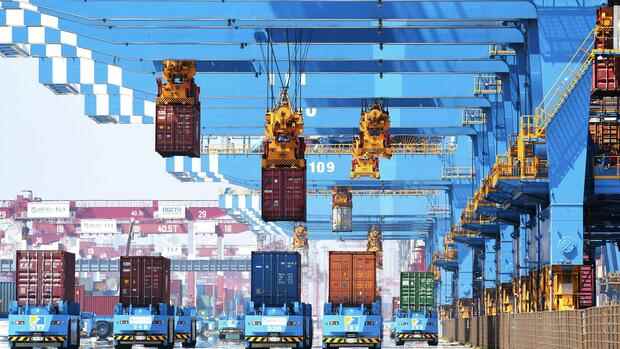China’s foreign trade increased strongly in November.
(Photo: dpa)
Beijing China’s foreign trade is booming: exports have lost some of their momentum, but imports are exceeding expectations. As the customs reported on Tuesday in Beijing, foreign trade in US dollars rose sharply in November by a total of 26.1 percent compared to the same month last year.
However, exports only grew by 22 percent after the increase in October had been 27.1 percent. In contrast, imports rose surprisingly by 31.7 percent – after 20.6 percent in the previous month.
However, German exporters were able to benefit little from the flourishing foreign trade of the second largest economy. China’s imports from Germany only rose 3.3 percent. In contrast, Chinese exports to Germany rose sharply by 28.9 percent.
It is similar with the European Union: While Chinese exports to the EU climbed by 33.5 percent, imports from the EU remained weak with a small plus of 4.2 percent.
Top jobs of the day
Find the best jobs now and
be notified by email.
China’s lower export growth was attributed to weaker demand and higher production costs. The strong import growth, which clearly exceeded the forecasts, can also be explained by the sharp rise in coal imports and higher costs for energy sources. The value of coal imported into China because of energy shortages rose by as much as 769 percent to $ 5.87 billion. The trade surplus was $ 71 billion in November, less than October’s $ 84 billion.
Exports contributed 40 percent to economic growth in the first three quarters. But this trend should weaken.
China wants to grow by at least six percent in 2021
The ongoing pandemic, high raw material prices and other uncertainties such as the crisis in the real estate sector could put a brake on growth in the coming year. During the Communist Party’s annual political bureau deliberations on economic policy for the coming year, a leading state think tank proposed setting a lower growth target of “more than five percent”.
This gives leeway: “It would allow all parties involved to focus on promoting reforms and innovation in order to achieve high-quality growth,” said Li Xuesong, economic researcher at the Academy of Social Sciences (CASS), according to state media.
This year, China is still aiming for growth of “more than six percent”. At a meeting with the heads of major business organizations, Prime Minister Li Keqiang was confident that the goals would be achieved.
The prime minister expects a “long-term healthy development”. “The Chinese economy is resilient and has potential,” said Li Keqiang at the meeting on Monday evening. “China is able to deal with short-term economic fluctuations.” The CASS economic researchers also recommend an inflation target of again around three percent, a budget deficit of around three percent and the creation of eleven million jobs in cities for his economic plan for 2022.
Against the background of the ongoing trade war with the USA, which also wants to enforce more exports to China, Chinese imports of US goods rose by 22.1 percent. Chinese exports to the United States were only up 5.3 percent.
More: Didi founder Cheng Wei faces turbulent months after the stock market pull-out
